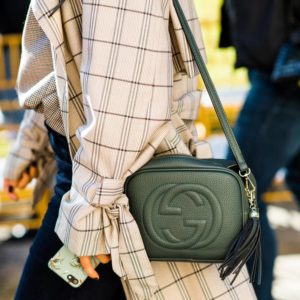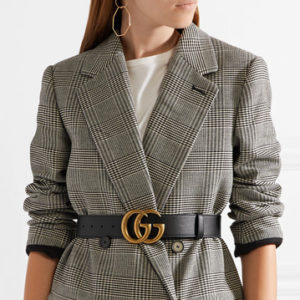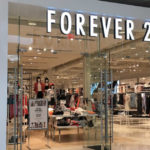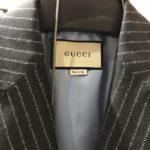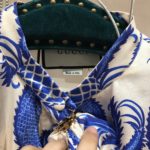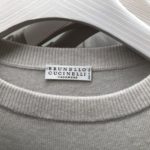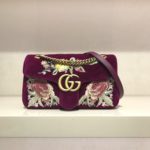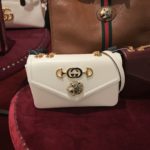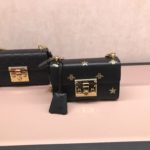Monthly Archives: March 2019
Fashion Speaks
my webstie –
i realized i think i published it the wrong way or something, but hopefully you can see it now
Made-in-Italy Across the Page
Interested in learning about what your journal design has to say about your taste for Made-in-Italy? Visit https://ita-stationery.tumblr.com to discover how the Made-in-Italy label has impacted stationery brands and product designs for the notebooks and planners you write your thoughts and ideas in.
Web 2.0
Web 2.0: Influencers Influencing Fashion Marketing
Technology has grown exponentially over the past two decades, depicted in the chart on technology ownership trends by Pew Research below.  There is no doubt that our attachment to technology has a large influence on our day to day lives. Anytime there’s a slow moment, we reach for our phones to occupy the time – flipping through social media, liking a few posts, replying to others, and absorbing what the internet inexplicitly tells us to value.
There is no doubt that our attachment to technology has a large influence on our day to day lives. Anytime there’s a slow moment, we reach for our phones to occupy the time – flipping through social media, liking a few posts, replying to others, and absorbing what the internet inexplicitly tells us to value.
With the growth of social media, what it means to be an influencer has shifted. Before, influencers were limited to celebrities. Their artistic profession as musicians and actors requires a high level of public visibility, resulting in higher social status and influential power over their fan-base.
However today, the Internet allows anybody to achieve this high level of visibility to become an influencer. Fashion blogs develop a following of consumers who enjoy the particular brand a person created for themselves and which they use to share personal opinions and knowledge in fashion and beauty. Thus influencers convey to their audience what to value, what is important, and what is trending. By sharing one’s life, values, passions, and talents, anybody can use the Internet to build a community, a paying job, and increase their social status.
The number of influencers is growing, along with their influence on consumers’ activity. This is reshaping brands’ marketing techniques. Many companies believe that to effectively market to consumers, whose eyes are most often turned on social media, they must reach out to influencers to request that the influencer endorse their product. Thus brands reach that influencer’s unique set of consumers who are told that this product should be interesting to them based on the influencer’s support of it.
Gucci and Italian brands’ success
For instance, let’s consider Gucci. Gucci was founded in 1921 by Guccio Gucci in Florence, Tuscany. They view themselves as 21st Century innovators and take pride in their luxury status, quality product, and Italian brand. Continually, Gucci Equilibrium is where Gucci explicitly shares their goals – Culture of Purpose – and updates their consumers on what they are doing to not only provide high-quality products that appeal to their consumers, but also protect the environment, abide by strong ethics, and protect their integrity and consumers’ respect for their company.
Gucci is one of the most successful fashion brands on the market. According to The Lyst Index, a quarterly analysis of the “hottest brands” based on Internet searches, purchases, and engagement, Gucci was the number one hottest brand of 2017. In 2018, they were number one in the fourth and second quarters and number two in the third and first quarters.

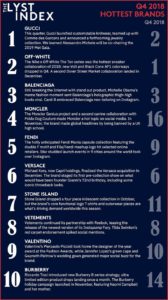
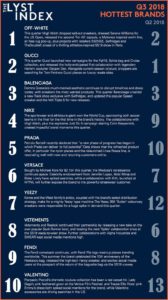
Across each of the four quarters in 2018 and the hottest brands of 2017 overall, all of the brands are high-end luxury brands and the large majority of them are Italian.

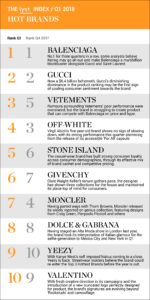
So, what makes Italian fashion so successful? Is it their association with Made-in-Italy, the high quality, well-made products?
Or is there something else, such as their marketing and social media techniques that are raising them up above luxury fashion labels in France, Britain, or the United States?
Gucci (and other Italian fashion labels) were reluctant to take part in the social media and influencer marketing strategy of today. They are older established brands who cater to an exclusive high-class customer. Therefore, they most likely viewed the publicity and mainstream nature of social media as beneath their brand. Yet, in early 2015, Gucci was struggling. They had poor sales because they were seen as outdated.
Since then, Gucci embraced social media and influencer marketing. As Gucci went about remarketing their brand and accepting social media as a necessity, it appears that they focused on being more deliberate when using influencer marketing, sticking only to working with a small number of influencers. This strategy allows them to maintain some more control over their image while taking advantage of the benefits of social media outreach, resulting in over 50% of their sales coming from millennials in 2017.
What about other non-Italian brands?
According to Gartner L2’s 2018 Digital IQ Index: Fashion Global, Gucci has the highest digital IQ of the global fashion industry; however, most of the following brands are not Italian.
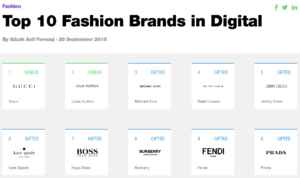
- Gucci
- Louis Vuitton
- Michael Kors
- Ralph Lauren
- Jimmy Choo
- Kate Spade
- Hugo Boss
- Burberry, Fendi, Prada
If these other, non-Italian brands have better digital marketing than Italian brands, then why are there so few that make it in the top 10 on The Lyst Index?
In November 2018, Michael Kors reported earnings that were less than expected for fiscal quarter two and saw their shares drop over 14%. They are struggling to maintain their brand prestige as their bags can be found at TJ Maxx and Marshalls at discount prices. Their high success in the digital sector could be an indicator of their effort to bounce back and make their products more desirable again, as opposed to an indication that their brand is particularly successful.
Made in Italy
Italian brands have something going for them that luxury fashion brands from other countries do not: Made in Italy. The Made in Italy brand, as described in Sonnet Stanfill’s Italian Style, means high quality, long lasting products that are hand-crafted by skilled and well-compensated laborers using the best materials possible. Consumers who purchase a Made in Italy product know that they are getting the best possible.
Luxury brands from America, France, or Britain do not have the benefit of being a part of an all-encompassing brand such as Made in Italy. Perhaps this is why they are higher on the list for digital IQ; they need to work harder than Italian brands to engage their consumers.
Additionally, as with Michael Kors, other labels may be struggling to maintain their image as a prestigious luxury brand. Italian brands, because they are Made in Italy, already have that status of prestige and know it. They keep a tight watch over their production and sales to prevent from losing their prestige because of overexposure or discounted prices.
While social media and influencer marketing is essential to maintain consumer engagement and sales, a brand cannot survive solely on a strong media presence. The Made in Italy brand brings pride to Italian fashion labels and helps them maintain their success in the fashion industry through their commitment to a great product, allowing them to rise above luxury fashion brands from other countries.
References
“About Gucci.” Gucci Official Site United States, Guccio Gucci S.p.A, www.gucci.com/us/en/st/about-gucci.
Farooqi, Alizah Asif. “Top 10 Fashion Brands in Digital.” Gartner L2: Benchmarking Digital Performance, Gartner, Inc, 28 Sept. 2018, www.l2inc.com/daily-insights/top-10-fashion-brands-in-digital-4.
“Gucci Belt Outfit.” Net-a-Porter, Net-a-Porter, www.net-a-porter.com/us/en/product/741153/gucci/leather-belt.
“Gucci Logo.” Wikipedia, Wikimedia Foundation, Inc., en.wikipedia.org/wiki/Gucci.
Hanbury, Mary. “Michael Kors Is in Danger of Getting ‘Lost in a Sea of ‘Stuff”.” Business Insider, Business Insider, 7 Nov. 2018, www.businessinsider.com/michael-kors-tj-maxx-image-problem-analyst-2018-11.
“Home.” Gucci Equilibrium, Guccio Gucci S.p.A, equilibrium.gucci.com/?utm_medium=gucci.com&utm_source=gucci.com_us&utm_campaign=equilibrium_launch_june18&utm_content=footer.
Luna, Becca Risa. “Gucci Bans Influencer Gifting, Here’s What They’re Doing Instead.” Coffee and Handbags, WordPress, 23 Sept. 2018, coffeeandhandbags.com/2018/09/13/gucci-bans-influencer-gifting-heres-what-theyre-doing-instead/.
Pew Research Center. “The Share of Americans Using Various Technologies Has Stayed Relatively Flat since 2016.” Pew Research Center, Http://Www.pewresearch.org/Fact-Tank/2018/09/28/Internet-Social-Media-Use-and-Device-Ownership-in-u-s-Have-Plateaued-after-Years-of-Growth/, 28 Sept. 2018. Survey conducted January 3-10, 2018 and trend data are from previous Pew Research Center studies
“The Lyst Index 2017 / Hottest Brands of the Year: 2017.” Business of Fashion, Lyst, www.businessoffashion.com/articles/sponsored-feature/the-hottest-brands-in-2017-gucci-vs-balenciaga.
“The Lyst Index / Q1 2018.” Business of Fashion, 24 Apr. 2018, www.businessoffashion.com/articles/sponsored-feature/the-truth-about-vetements-and-fashions-hottest-brands-and-top-selling-products-in-q1.
“The Lyst Index / Q2 2018.” Lyst, 2018, www.lyst.com/news/lyst-index-q2-2018/.
“The Lyst Index / Q3 2018.” Snobette, 24 Oct. 2018, snobette.com/2018/10/hottest-brand-off-white-gucci-balenciaga/.
“The Lyst Index / Q4 2018.” The Moodie Davitt Report, 7 Feb. 2019, www.moodiedavittreport.com/gucci-named-worlds-hottest-brand-in-lysts-quarterly-fashion-rankings/.
“Made in Italy Logo/Image.” Business e via Italy, Business e via Italy, www.businesseviaitaly.com/single-post/2017/06/21/%E2%80%9CMade-in-Italy%E2%80%9D-export-keeps-accelerating-4-growth-in-the-next-four-years-up-to-%E2%82%AC490-billion.
Semburg, Sandra. “Street Style with Gucci Bag.” Vogue, Condé Nast Britain, 3 Jan. 2019, www.vogue.co.uk/article/the-most-iconic-gucci-bags-of-all-time.
WWC Staff. “Gucci: A History Lesson.” WWD, Penske Media Corporation, 23 Feb. 2011, wwd.com/fashion-news/designer-luxury/history-lesson-3512770/.
“Back To Our Roots” – Sustainable Fashion
The tradition of Italian Fashion practice
Italian fashion has always been extremely well-regarded. It is known for its careful production and regional materials, providing genuine elegance and national pride. Italy did not participate in the first wave of industrialization in the nineteenth century, leaving Italian design to be dominated by small companies, which were commonly family-owned. As the economy grew, companies gained more power and more ability to experiment with design, allowing for Italian makers to still be innovative and well-renown. Italy is still regarded as one of the leading countries in fashion design, and even though manufacturing and production may have shifted to accommodate buyer needs, the thought of a product being “Made in Italy” still reminds consumers of carefully crafted, innovative, goods, which go above and beyond meeting a consumer’s needs.
Fast Fashion Now
American fashion, unfortunately, is not regarded in the same luxurious way. This may be due to the abundance of fast fashion, cheaply-made clothing that is quickly produced at low prices in order to satisfy customer demand and the desire for affordability. In theory, for those who are intrigued by fashion and love a plethora of styles and dressing opportunities, this is a wonderful thing. However, the behind-the-scenes actions taken to keep costs low are detrimental to our environment and horrifyingly unethical. Additionally, the abundance of clothing that is produced at such a low cost encourages over consumption, leading to extreme textile waste. Common, cheap, materials such as polyester, which is man-made, are made of non-biodegradable materials, inevitably creating waste. Polyester also requires an immense amount of energy to create. Cotton, a very standard material in most shirts, jeans, pants, and more, requires tons upon tons of water consumption to produce, making up over 70% of water consumption in the industry. The workers in textile factories abroad are kept in extremely poor, sweatshop conditions, working in tight-spaces with poor ventilation, forced to breathe in air concentrated with chemical dyes and fumes. These often toxic dyes are also secreted into natural water sources once fashion is improperly disposed of, collecting in waste piles, impacting the innocent lives of those living in surrounding villages. The impact of fast fashion is one that many are not aware of, but constantly contributing to in their daily purchases.
Italian Luxury Brands Now
This problem is not specific to US brands. All fashion brands can be evaluated in terms of their eco-consciousness. Some of the most famous Italian fashion brands, such as Valentino, Versace, Prada, and Armani, have been rated in terms of their environmental impact and ethical treatment of employees, and have received the following critiques and ratings from the websites “rankabrand.org” and “goononyou.eco”. Both of these websites are easy ways to assess commonly purchased brands. Valentino receives very poor ratings, mainly due to the failure to communicate environmental policy, and lack of commitment to its employment code of conduct, and production in low-wage countries. Versace receives similar ratings, specifically having to do with its resistance to follow standards set by Greenpeace’s “Detox” campaign, with motives to eliminate hazardous chemicals. Prada also receives similar ratings, although being commended for its efforts to reduce energy consumption and working towards 100% renewable energy, although with no outlined plan of doing so. Armani has taken some steps to reduce environmental impact, such as establishing a deadline of 2020 to eliminate hazardous chemicals. However, this is all it has promised so far.
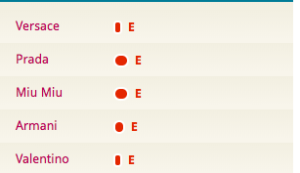
Struggles Sustainable Fashion Faces
Sustainable fashion, clothing production that favors the upkeep of our natural environment and fair treatment of workers, is a simple solution to these horrifying problems faced in the industry. However, start-up brands in this sector still face many difficulties, and no brands designated to be sustainable are household names. I spoke to Carmen Gama, a designer at Eileen Fisher RENEW, a take-back program accepting worn and torn Eileen Fisher garments and turning them into brand new, wearable designs, who said the main barriers the company faces due to the commitment to sustainability was that “cost of goods and production are higher, making it hard to be accessible to different demographics”. Meagan Neville, founder of Workspace Collective, a curated collection of sustainable products expanded on this, describing the struggles with marketing of products pertaining to storytelling. “When I’m selling $40 t-shirts, and $80 jeans, I have to tell a story of why and explain so people know they are buying something great, so it’s important to weave that educational aspect in.” Meagan also described the differences in design for sustainable and typical, fast fashion brands, as she has experience in product development at Macy’s, Inc., under Style&Co., Charter Club, and Alfani, in addition to a plethora of smaller, sustainable, ethically-focused companies. She said, “there was no room for creative expression working with Macy’s, it was lifestyle branding, so you were given a customer to create for, who liked consistency, so it was so stagnant. Whereas, with fair trade brands, your shopper was someone who was a little more expressive, and willing to be more adventurous with their style, so it was fun to create for that customer.” Both designers favored the intent and creation of sustainable design, despite these struggles.
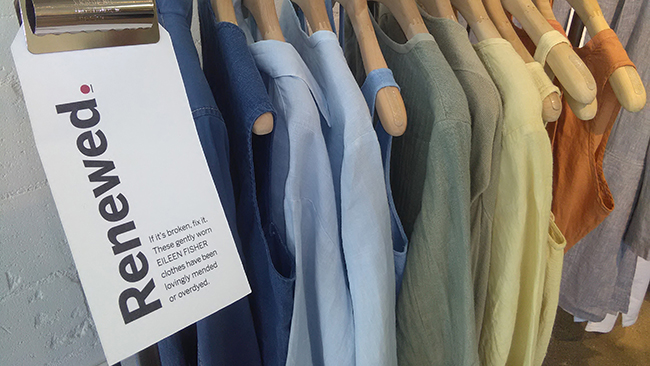

Different certificates of sustainability and ethics
While the message and gravity of the situation is relatively easy to understand, it may be hard to navigate how one can go forward supporting and celebrating the correct brands, evaluating their environmental impact. As we saw with Italian luxury brands, great impacts and poor conditions can be disguised by a high price tag, eliminating the price of a good as an indicator of quality of production. It is also hard to define the threshold of “good enough”, in terms of policy. Meagan Neville’s standards for the companies she sells are: “utilizing upcycled or repurposed material, natural fibers, artisan-made products preserving cultural tradition, utilizing fair trade or it is documented that workers are paid fair wages and work in safe conditions, and made in USA supporting local production”. To sell a brand in her collection, she requires that they meet at least two of these criteria. The average customer can look for brands that are B-corp certified, showing the highest standards of social and environmental performance and transparency. Additionally, websites and databases such as “goodonyou” and “rankabrand” allow for the easy assessment of any brand. Sustainable fashion may pose barriers in terms of marketing and design, but armed with the correct resources, consumers are capable of supporting companies that are helping to improve the standards of human-environment interaction and the treatment of workers.
Sources:
Maffei-Fallan Made in Italy
Goodonyou.eco
Rankabrand.org
THE GRADIENT
My topic is contrasting fast fashion and luxury fashion. Today, two main types of fashion purchases can be seen: purchases for really inexpensive clothing that is worn once, or much more expensive name brand clothing that holds a certain prestige when worn. The former is called fast fashion; examples of fast fashion retailers include Forever 21, Zara, H & M, and other companies that mass produce, cheap, trendy clothes for rock bottom prices. The latter, can be called luxurious fashion. Luxury fashion includes clothing and shoes made by designers like Gucci, Prada, Chanel, Louis Vuitton and others like them. Consumer purchasing of these brands is quite different from consumer purchasing of fast fashion. People purchase fast fashion with a much higher value for quantity than quality. With prices that are so low people buy these trendy items in high volumes, only to wear each item once or twice. The low price assuages their guilt for only wearing it once. Recently an article came out in Vogue talking about the low prices of fashion. It walked about a dress H&M was selling for $4.95; the article was titled, “Do I get coffee, a snack, or something to wear?” There seems to be a sharper gradient between the two extremes of fashion without many retailers that offer something in the middle.
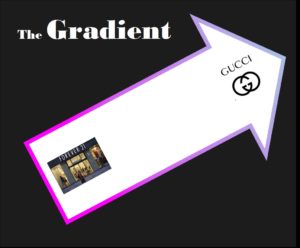
For my project the main stores I visited were Gucci, and Louis Vuitton. Though Louis Vuitton is not an Italian brand, it is a highly regarded and established luxury brand which helped me to judge luxury brands in general (Italian or not). While I was at the mall, I briefly stopped by another Italian luxury store, Brunello Cucinelli. For fast fashion, I focus specifically on Forever 21 because it is one of the more popular fast fashion stores for my generation. Since the store was so far away, I opted to interview some of my peers on their forever 21 experiences instead of travelling there. This project’s main purpose is to examine the main differences between fast fashion and luxury fashion.
Some of the differences I noted between Luxury fashion and fast fashion:
- In both Gucci and Louis Vuitton, the stores were extremely spaced out with individual items placed relatively far away from each other. When interviewing my friends on Forever 21, they described the store as cluttered and disorganized. One friend even said the clutteredness could make the store stressful to attend.
- In the luxury stores, there were few options, whereas in fast fashion stores like Forever 21, there is such a wide array of options. One interviewee said, “I like shopping at forever 21…there are so many options, but it is definitely a time commitment.”
- The customer service received at the luxury fashion stores was phenomenal. I was greeted with a warm smile and shown around the store. The sales representative showed me her favorite items in the store and told me about their different limited-edition collections. In fast fashion stores, it is typically a “free for all” with very limited customer service. You pick out your own clothes, and chances are, if you ask a sales representative about the history behind an article of clothing, they will not know the answer. On the other hand, in the luxury fashion stores, the sales representatives were very knowledgeable about their products.
- One obvious difference in fast fashion and luxury fashion is the price point. At most fast fashion retailers, you can leave the store with pants, a top, and another accessory without having to pay more than $20 for all of them combined. On the other hand, at Louis Vuitton, the sales representative described a $100 scarf as “inexpensive.”
There is one interesting similarity between fast fashion and luxury fashion. When people buy either fast fashion or luxury fashion, they don’t buy the clothing out of a true admiration for it. With fast fashion it is often “good enough” for the price they are paying, and for luxury fashion, often consumers are paying for the brand name status rather than the article of clothing itself. When describing why she loves shopping at Forever 21, a peer explained, “see, I like shopping for quantity not quality.” She explained that the clothes she gets from Forever 21 did not have to be the greatest thing ever, or last her for a while, she just liked shopping in volume, and with the prices that Forever 21 offered, that was possible.
Overall, this experience was really enlightening. Though the main point of my project was the two extremes, rather than the middle values, I did happen to notice during my trip to the mall that some middle fashion retailers are, fortunately, gaining popularity, like Madewell, or Free People. This could be a really good sign for the future and suggest that the gradient is not getting sharper, rather, it is becoming less extreme with mid-priced, mid-value fashion retailers.
What’s in a name?
Gallery
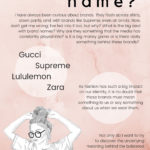
This gallery contains 7 photos.
What’s in a name? I have always been curious about brands. They flash across shirts, down pants, and, with brands like Supreme, even on bricks. Now, don’t get me wrong; I’ve fed into it too, but why? What is the … Continue reading
FILA
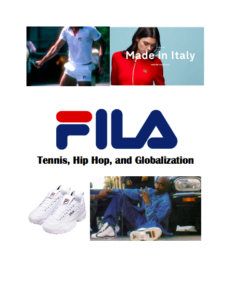
FILA: Tennis, Hip Hop, and Globalization
FILA is an Italy brand which was founded in 1911 in Northern Italy. Overtime, FILA has evolved from a mountaineering company to creating sportswear and streetwear. FILA has retained its Italian history and branding and continues to incorporate Made in Italy into its clothing today as the brand globalizes and is now based outside the country. This page explores FILA’s history and evolution as a brand and its place in the streetwear and sportswear industry today.
Watch for an overview of the project! https://youtu.be/u7Jcun3fmF4
FILA’s beginning
 In 1911, the two FILA brothers opened a textile company in the small town of Biella in the foothills of Northern Italy. The brothers took inspiration from the Italian landscape around them as they strove to produce luxurious fabrics.
In 1911, the two FILA brothers opened a textile company in the small town of Biella in the foothills of Northern Italy. The brothers took inspiration from the Italian landscape around them as they strove to produce luxurious fabrics.
Expansion

In 1923, FILA officially established itself as a knitwear manufacturing company, entering into a partnership with Maglficio Biellese and expanding outside of Biella. The company mainly produced textiles and also introduced a line of undergarments. In 1942, FILA merged with the Fratelli Fila company. By this point, the company had expanded outside its small town basis and even beyond Italy.
Transition to Tennis
 In 1968 Giansevero Fila hired Enrico Frachey. The pair envisioned FILA as a sportswear brand, and together moved the company away from textile production and towards becoming a global sportswear brand. The pair took note that athletics were becoming an essential part of how many Italians spent their leisure time, and reacted to this cultural change by shifting the brand’s focus.
In 1968 Giansevero Fila hired Enrico Frachey. The pair envisioned FILA as a sportswear brand, and together moved the company away from textile production and towards becoming a global sportswear brand. The pair took note that athletics were becoming an essential part of how many Italians spent their leisure time, and reacted to this cultural change by shifting the brand’s focus.
Endorsement and Establishment

 In the early 1970s, FILA forayed into the tennis industry. FILA sponsored many successful tennis players at the time, including Bjorn Borg, who won 5 consecutive Wimbeldons wearing FILA. Throughout the 70s and 80s, FILA had established its reputation as a respected brand in the world of tennis. Before FILA, tennis clothing was typically all white. In 1974, FILA introduced bright colors and prints to the sport, and changing the face of tennis fashion and becoming a staple brand within the sport.
In the early 1970s, FILA forayed into the tennis industry. FILA sponsored many successful tennis players at the time, including Bjorn Borg, who won 5 consecutive Wimbeldons wearing FILA. Throughout the 70s and 80s, FILA had established its reputation as a respected brand in the world of tennis. Before FILA, tennis clothing was typically all white. In 1974, FILA introduced bright colors and prints to the sport, and changing the face of tennis fashion and becoming a staple brand within the sport.
To the Streets
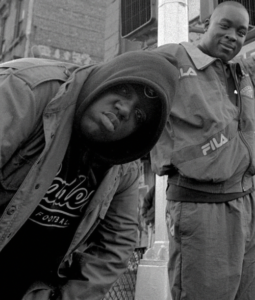 In the 1990s, FILA endorsed NBA star Grant Hill, attempting to expand the brand’s network in the United States. At the same time, FILA become one of the first brands to produce luxury priced streetwear. Track suits, sneakers, and other sporty attire became popular as general leisure clothing in Europe and the U.S. As basketball stars wore FILA, celebrities began to wear FILA as well. Rappers such as Tupac and the Notorious B.I.G. were often seen wearing FILA and were included in FILA’s campaigns. FILA’s brand came to represent high quality, casual street style.
In the 1990s, FILA endorsed NBA star Grant Hill, attempting to expand the brand’s network in the United States. At the same time, FILA become one of the first brands to produce luxury priced streetwear. Track suits, sneakers, and other sporty attire became popular as general leisure clothing in Europe and the U.S. As basketball stars wore FILA, celebrities began to wear FILA as well. Rappers such as Tupac and the Notorious B.I.G. were often seen wearing FILA and were included in FILA’s campaigns. FILA’s brand came to represent high quality, casual street style.
Troubles in the 2000s
 In the early 2000s, FILA’s brand awareness and sales began to falter. The Italian ownership sold the brand to an American hedge fund. FILA was operated through a global holding company, except in South Korea, where Fila Korea remained independent. In 2007, Fila Korea acquired FILA’s global brand. Today, FILA is headquartered and operated out of South Korea.
In the early 2000s, FILA’s brand awareness and sales began to falter. The Italian ownership sold the brand to an American hedge fund. FILA was operated through a global holding company, except in South Korea, where Fila Korea remained independent. In 2007, Fila Korea acquired FILA’s global brand. Today, FILA is headquartered and operated out of South Korea.
FILA in the age of globalization
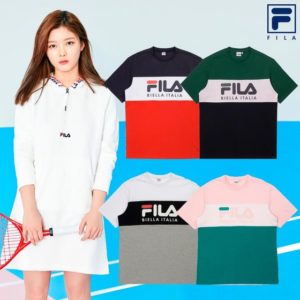 Although FILA is based out of South Korea today, the brand retains its Italian heritage and influence. In 2007, FILA partnered with Global Leading Brands House, an organization aimed at helping high end brands develop. FILA established a headquarters in Milan, Italy.
Although FILA is based out of South Korea today, the brand retains its Italian heritage and influence. In 2007, FILA partnered with Global Leading Brands House, an organization aimed at helping high end brands develop. FILA established a headquarters in Milan, Italy.
Ruling the Runway
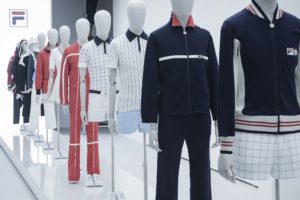 FILA recently released a “Made in Italy” clothing line, featuring clothing designed and produced in Italy. On September 23, 2018, FILA had its runway debut in Milan Fashion Week for the first time ever. Additionally, FILA has partied with Fendi, combining the signature FILA “F” logo with the Fendi name and branding it on bags and other accessories.
FILA recently released a “Made in Italy” clothing line, featuring clothing designed and produced in Italy. On September 23, 2018, FILA had its runway debut in Milan Fashion Week for the first time ever. Additionally, FILA has partied with Fendi, combining the signature FILA “F” logo with the Fendi name and branding it on bags and other accessories.
Returning to the Streets
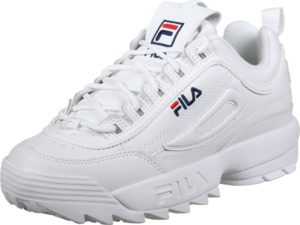 FILA has regained influence in streetwear and abroad as well. FILA has seen success in South Africa, and has expanded throughout that market. The brand recently partnered with Urban Outfitters, bringing it to a trendy and youthful audience. FILA has also relaunched its iconic sneaker, a staple of the brand during its peak popularity in the 80s and 90s.
FILA has regained influence in streetwear and abroad as well. FILA has seen success in South Africa, and has expanded throughout that market. The brand recently partnered with Urban Outfitters, bringing it to a trendy and youthful audience. FILA has also relaunched its iconic sneaker, a staple of the brand during its peak popularity in the 80s and 90s.
The Future of FILA
FILA has evolved as a brand over the past hundred years and has adapted to trends of pop culture and global markets. As Italians engaged in more athletics, FILA shifted to an athletic wear company. As street style became more causal in the 1990s, FILA was at the cutting edge of producing leisure clothing and outfitting the streets of Europe. Although the brand struggled at the turn of the century, its history of evolving to changing markets suggests the brand will adapt to modern markets. FILA has reestablished its name as a producer of high quality fashion, which was demonstrated as it had a show in Milan Fashion Week, and in the brand’s recent partnership with Fendi. FILA is targeting its streetwear at youth in markets around the world, and their recent partnership with Urban Outfitters will expose the brand to a young and hip audience.
Given todays trends in fashion and streetwear, FILA’s revival could not come at a more perfect time. In the past ten years, the athletic wear industry has grown substantially. Brands producing athleisure, or athletic wear worn for leisure, have seen massive success. Lululemon is an athletic wear brand which promotes a healthy, active lifestyle, at a time when being healthy is very trendy. Yeezy, which is Kanye West’s brand, produced luxury priced athletic style streetwear. Yeezy is very popular among celebrities. FILA produces high quality athletic wear and casual clothes. If FILA stands by their Italian history and continues to produce high quality athletic garments, it appears as though FILA will see revived popularity and success in the future.
Author: Emily Hurren, student at Vanderbilt University
Sources:
https://www.fortressofsolitude.co.za/sneaker-history-fila/
https://www.nssmag.com/en/fashion/16189/fila/image:153235
American and Italian Fashion
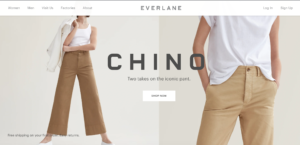 The company I want to investigate is Everlane, which is an American company whose headquarter are in San Francisco, California. Although being identified as an American fashion brand, this company sells specific products that are “Made in Italy” or “100% Italian feather,” according to the product descriptions. It well represents a combination of American and Italian fashion. I’m always curious about and interested in what “Italian fashion” means and represents in nowadays’ globalized fashion market. Especially how the classical Italian idea of fashion “sprezzatura” (effortlessly chic) is involved in the design of an Italian style fashion product. When I found this brand, I thought my questions were dissolved. The Italian leather products of Everlane explains what Italian fashion is very clearly.
The company I want to investigate is Everlane, which is an American company whose headquarter are in San Francisco, California. Although being identified as an American fashion brand, this company sells specific products that are “Made in Italy” or “100% Italian feather,” according to the product descriptions. It well represents a combination of American and Italian fashion. I’m always curious about and interested in what “Italian fashion” means and represents in nowadays’ globalized fashion market. Especially how the classical Italian idea of fashion “sprezzatura” (effortlessly chic) is involved in the design of an Italian style fashion product. When I found this brand, I thought my questions were dissolved. The Italian leather products of Everlane explains what Italian fashion is very clearly. 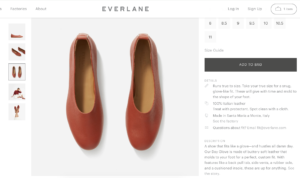
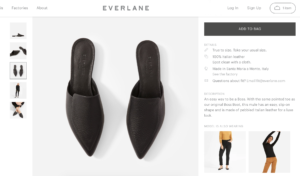
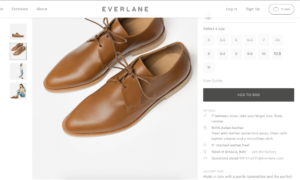
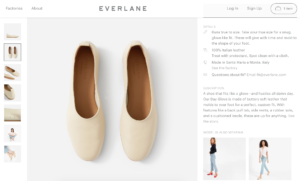
Every pair of shoes this company designs has a very simple outline and is meant to be comfortable to wear. Each shoe seems to speak to the consumers that if you buy it, your life will get easier and your life quality will be leveled up. The brand advertises heavily on how comfortable and simple its shoes are. To facilitate the comfortability of its shoe line, the company focuses a lot on the quality of the raw materials, using minimum decorations on their products to make sure they maintain the texture of their raw materials, which coincides with the reading “Italian Fashion Designers in Hollywood” we read in Stanfill’s book about Italian fashion and what we’ve discussed with Del Conca from the Italian tile company. In the meantime, the brand also absorbs some American elements into its designs. For example, one type of shoes often comes with various color choices for consumers who want a variety of colors in their shoe cabinet instead of just black and white. Also, the models who wear these shoes appear to be very brisk, which is more Americanized and very different from some poker faces that we usually see on some high-end fashion brand models. This not only displays how comfy these shoes are but also balances the formal feeling brought by the designs of the shoes. Continue reading

